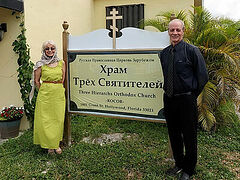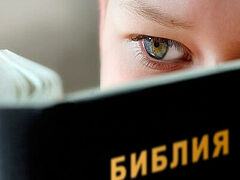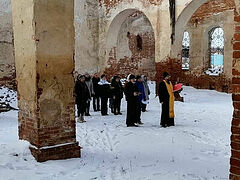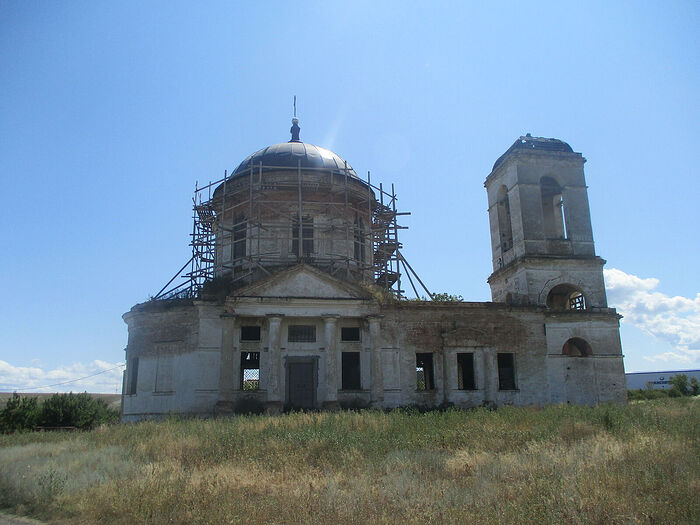 The Church of the Resurrection of Christ in Akhmat
The Church of the Resurrection of Christ in Akhmat
To get to Akhmat you must travel from Saratov to Krasnoarmeysk, a.k.a. Balzer—now the center of the right-bank area of the Saratov region, in the past—the center of the Balzer district of the Autonomous Republic of the Volga Germans. Krasnoarmeysk still stands out for its cleanliness, well-cared for solid German houses built of beautiful two-tone bricks. And this is the new Orthodox Church of the holy Apostles Peter and Paul, in which Priest Anatoly Filonenko serves. After the Sunday Liturgy we went to Akhmat with him.
Father Anatoly celebrated a prayer service at the old Church of the Resurrection of Christ built in 1829. This church was at one time closed, desecrated, its interior shattered, and it served as a vegetable storehouse for several decades... And then an enterprising local resident decided that the abandoned church would make a good shed for three dozen of his cows. And all appeals to the conscience of the cattle breeder were in vain.
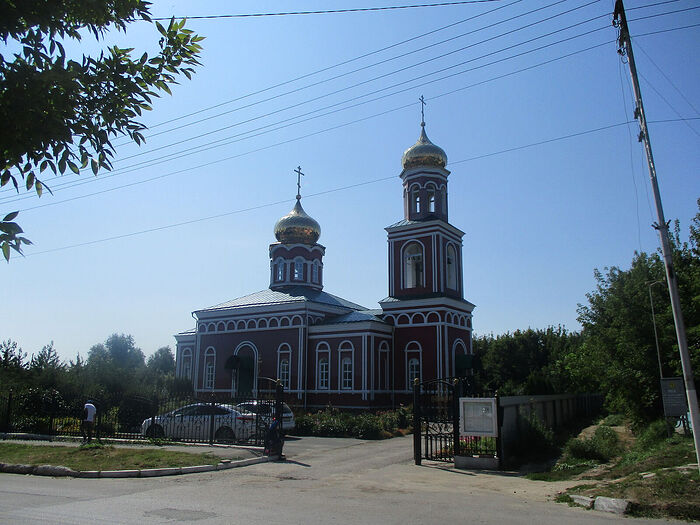 The Church of the holy Apostles Peter and Paul in Krasnoarmeysk
The Church of the holy Apostles Peter and Paul in Krasnoarmeysk
“He said that no one needed this church anyway,” Fr. Anatoly related on the way to Akhmat. “And only when we registered the building as the parish property were we able to tell him clearly: ‘No, this is our church, and the cattle will no longer be kept here.’”
“How did you start to restore the church in Akhmat?” I asked.
“I would not have undertaken this work if I had not seen the people who needed the church. Some of our parishioners from Krasnoarmeysk have holiday cottages there, and local residents would also come to the city to attend services. They came up to us priests and almost cried, telling us about the state of the church in Akhmat. But the most important thing is that they were not only ready to complain—they were also ready to get involved and help. Therefore, with the head of the Deanery, Archpriest Nikolai Formazyuk, we decided that we would, as far as possible, renew the church. And the ruling hierarch, Bishop Tarasy of Balashov and Rtishchevo, gave us his blessing.
Fr. Anatoly Filonenko is a native of Balzer. Here, thanks to his grandparents, he began to go to church and later help the priest in the altar. He entered seminary, later graduated from it and returned home. He inherited beekeeping skills from his grandfather, and now he keeps bees. His family is still small—he has a wife, Anastasia, and a son named Mikhail.
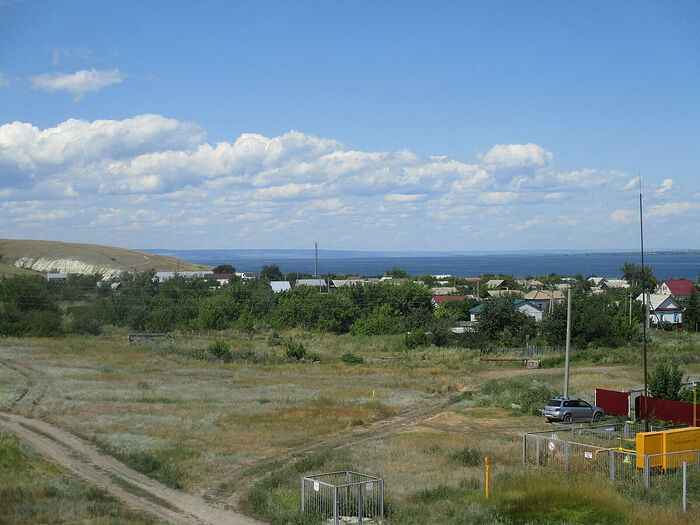 Akhmat. The Volga. A view from the church roof
Akhmat. The Volga. A view from the church roof
The Saratov region’s Right Bank is incredibly beautiful: hills, cliffs, forests, the high Volga banks, expanses—you could admire all this for hours. And the heart cannot reconcile itself to the fact that this land, like the whole hinterland of Russia, has become depopulated and desolate: villages are dying out, and people are leaving the major towns. But every village here is steeped in Russian history! From ancient times it was believed that the village of Akhmat was named after Ahmet Khan of the Great Horde, whose troops in 1480 stood against the army of Grand Prince Ivan III of Moscow on the Ugra River.1 The village was founded much later, at the beginning of the eighteenth century, but the name of Ahmet (Akhmat) was given to the mountain above the Volga—at one time the khan’s camp was on it. Eventually the village was called Akhmat too. This version was recognized by the well-known explorer of the Saratov region, Alexander Minkh (1833—1912) and other local historians.
In 1796, immediately after his accession to the Russian throne, Emperor Paul I presented his favorite Peter Khrisanfovich Obolyaninov (1752–1841), Major General and Quartermaster-General, later—a prosecutor general of the Governing Senate, with 2000 souls in the Saratov province. So Obolyaninov owned Akhmat and the neighboring villages. In 1828—1829, at the end of his hectic career, Peter Khrisanfovich built a stone church in honor of the Resurrection of Christ in Akhmat to replace the old wooden one. In 1894, there were 2,859 souls in the parish of the Resurrection Church in the village. Today, according to official figures, there are forty-eight inhabitants in Akhmat. In the summer, the area comes alive thanks to summer residents. The neighboring village of Sadovoye fares somewhat better than Akhmat; some of its inhabitants come here, to the Resurrection Church, for prayer services and talks with the priest. Almost two dozen people normally gather.
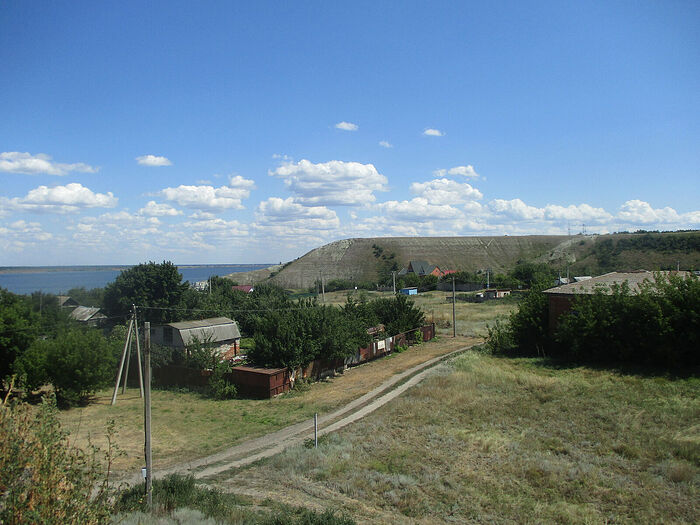 Akhmat. The Volga. A view from the church roof
Akhmat. The Volga. A view from the church roof
Fr. Anatoly and I arrived in Akhmat. True, today this church built by General Obolyaninov makes a tragic impression. But you and I didn’t see what was here at the time of the expulsion of the cows! A layer of debris and manure… “As you can see, a line on the wall still remains,” Fr. Anatoly said. And these old women, who were now coming to the service one after another, took all this out of the holy walls with their own hands, shovels and wheelbarrows.
“Maybe someone doesn’t need the church, but we need it!” said one of them, Lyudmila Yakovlevna, firmly. “We try to the best of our abilities, and we believe that the Lord Himself will help us. And we pray that we will all reach our goal, see our church in all its glory, and take Communion in it at the first Liturgy.”
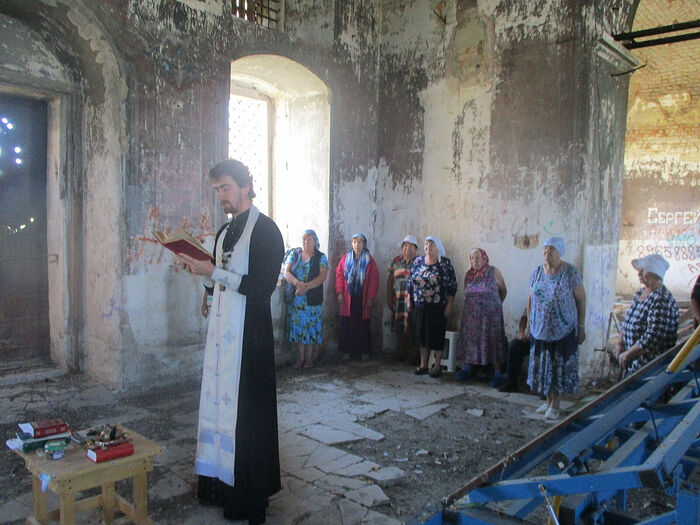 A prayer service in the Church of the Resurrection of Christ
A prayer service in the Church of the Resurrection of Christ
“Oh, they have a long way to go,” I thought. Some old churches in the outback of Saratov were luckier: wealthy fellow countrymen were found and began to donate generously. In a matter of a year or two the churches were restored to their former glory, ready for the great consecration. But the church in Akhmat hasn’t yet found rich friends. Fr. Anatoly has been raising money literally penny by penny—through the website, Instagram and WhatsApp. The maximum contribution from an anonymous donor was 100,000 rubles [equal to c. $1,367.—Trans.]. Before the pandemic the church in Akhmat was supported by musicians: two charitable concerts of different genres were held at the Saratov State Conservatory, and another at the Krasnoarmeysk Musical School; the professional band “Jazz Trio” played in it. Some jazz musicians who are well-known in Saratov—Eugene Surmenev, Dmitry Tolochkov and Pavel Ershov—played in Akhmat, in front of the entrance to the church. According to Fr. Anatoly, the musicians recently called again—they want to continue interaction. All this is invaluable support, but it is extremely hard to raise any significant amount of money in this way, and prices for building materials are skyrocketing.
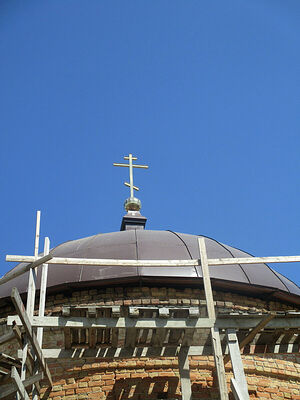 So have they started a hopeless undertaking? No. In July, good news appeared on the website of the Saratov Metropolia: A dome with a cross rose over the Resurrection Church in Akhmat. Previously, the roof was partially re-laid, and iron doors installed. People believe, and things, at least little by little, are moving forward. And I recall, one after another, stories of the revival of churches that I know, when at first the idea too seemed hopeless, and then things suddenly improved. Here is an example: St. Nicholas Church in the village of Strigay, located in the Bazarny-Karabulak district of the Saratov region. Priest Dionisy Kamenshchikov is the rector of the new St. Elias Church in the center of Saratov and he takes care of his large parish; but one day he drove into Strigay, saw a doomed St. Nicholas Church with the collapsed roof there and realized that he did not want to allow this church to become ruins. There were no resources at all, but like-minded people immediately appeared. The parishioners of St. Elias Church responded. The community began to travel to Strigay and clear the area with their own hands. Small donations then followed. And now there is a pile of bricks and planks by the church, the roof is being restored, so some urgent work is being done that will stop the destruction. And they have no rich donors either; but many a little makes a mickle.
So have they started a hopeless undertaking? No. In July, good news appeared on the website of the Saratov Metropolia: A dome with a cross rose over the Resurrection Church in Akhmat. Previously, the roof was partially re-laid, and iron doors installed. People believe, and things, at least little by little, are moving forward. And I recall, one after another, stories of the revival of churches that I know, when at first the idea too seemed hopeless, and then things suddenly improved. Here is an example: St. Nicholas Church in the village of Strigay, located in the Bazarny-Karabulak district of the Saratov region. Priest Dionisy Kamenshchikov is the rector of the new St. Elias Church in the center of Saratov and he takes care of his large parish; but one day he drove into Strigay, saw a doomed St. Nicholas Church with the collapsed roof there and realized that he did not want to allow this church to become ruins. There were no resources at all, but like-minded people immediately appeared. The parishioners of St. Elias Church responded. The community began to travel to Strigay and clear the area with their own hands. Small donations then followed. And now there is a pile of bricks and planks by the church, the roof is being restored, so some urgent work is being done that will stop the destruction. And they have no rich donors either; but many a little makes a mickle.
Lyudmila Yakovlevna was right: God Himself helps those who work and believe. In addition, the church in Akhmat has a great heavenly intercessor. “The Saratov Diocesan Gazette”, issue No. 23 dated December 1, 1899, reads:
“Archpriest John Sergiev of the town of Kronstadt donated 100 rubles to the church of the village of Verkhnyaya Dobrinka of the Kamyshin district [now in the Volgograd region, which the Saratov region borders in the south.—Trans.] for the purchase of a cast-iron stove for the altar, and 100 rubles to the church in the village of Akhmat in the same district, for its interior decoration.”
This means that a particle of the love that filled the holy pastor of Kronstadt was put into this church. And those who offer their mite to contribute to its restoration will imitate St. John.
We often hear or read the following comments on social media: “Is there any point in committing effort and investing funds to the restoration of churches in dying villages? Well, let’s assume it will be possible to restore them, but who will come to these churches to pray and celebrate the Eucharist in ten or fifteen, even in five years?”
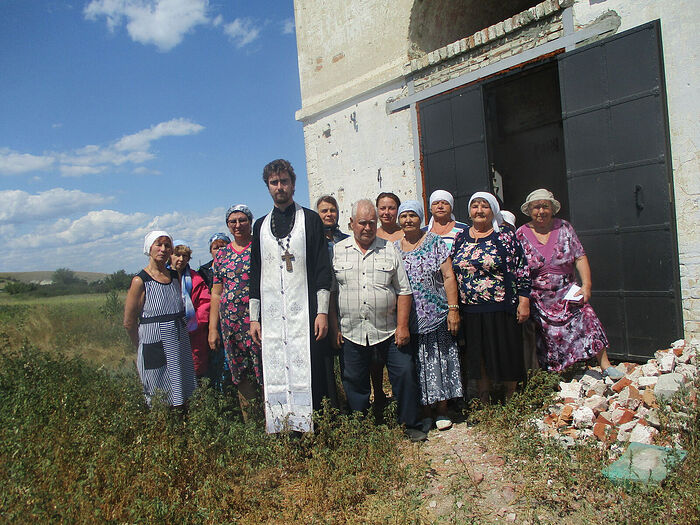 After the prayer service in the old church
After the prayer service in the old church
Yes, it is logical, but only in the earthly coordinates. A church is not just an architectural structure. It is a place of God’s special presence. From time immemorial, on coming to a new place Russian people would first of all build a church and then everything else because without a church, life in a new place could not begin. And today the regeneration of desecrated rural churches is almost the only thing that stands up to the general desolation. New life in this land won’t start if people leave their churches. A restored church really transforms people and changes life in the whole area. It gives hope. And that hope won’t be empty. This was also verified: Not a single restored church of our metropolia (and there are several dozen of them!) Is empty—each has a new lease on life.
Among the bare walls, covered with all sorts of graffiti, among the desolation that will certainly be overcome, Fr. Anatoly celebrated a prayer service and a Litia for repose of the departed, and preached a sermon on today’s Gospel. I squeezed through a narrow trapdoor, with the worn stone steps twisting around like a snail’s shell, and then climbed up to the church roof on a wooden ladder to see everything at once: the Volga, Akhmat Mountain, and the faraway forest.
I wish I could also see the future, in which the Word of God will be proclaimed within these long-suffering holy walls every day.
If you want to do your bit for the restoration of the church of the Resurrection of Christ in the village of Akhmat, here is the Sberbank card number: 4817 7601 8593 5925 (recipient: Anatoly Vladimirovich F. / Анатолий Владимирович Ф.). You can also do this by going to the church website:

